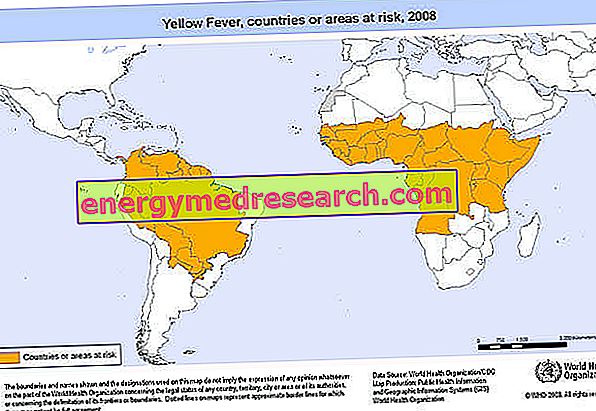Definition of yellow fever
Yellow fever is an acute infectious disease caused by the bite of infected mosquitoes: it is commonly known as black vomit, Antilles fever or, again, as typhoid .
Yellow fever is a serious health problem that particularly affects the tropical forests of central Africa and the southern Saharan area. Furthermore, yellow fever is endemic in certain areas of equatorial and southern America. No cases of yellow fever have been observed in Asia, Europe and Australia, although some potential vectors have been detected in some Asian areas [from Infectious diseases, by Mauro Moroni, Roberto Esposito, Fausto De Lalla]
The name "yellow fever" was coined for the first time around the middle of the eighteenth century by Hughes.
Incidence
Globally, medical statistics record 200, 000 cases of subjects suffering from yellow fever, of which 180, 000 are African (90%). However, after infection, a good portion of these patients do not experience any symptoms: for this reason, the incidence rate of yellow fever is inaccurate. It is estimated, in fact, that a good part of affected patients (ranging from 40 to 60%) is asymptomatic. In 5-10% of cases, yellow fever is fatal.

Causes
Yellow fever is caused by a virus, known as Flavivirus (Fam. Flaviviridae, Genus: Flavivirus); this has a spherical shape and does not exceed 70 nm. The envelope, lipoprotein, encloses an icosahedral nucleocapsid where, inside, the core protein and the genome (single-stranded RNA) are localized.
It should be pointed out that the infection of yellow fever cannot be transmitted directly from the virus to man: the mosquitoes of the genus Aedes are the vectors, responsible therefore for the transmission of the virus to the human being. In all probability, the most dangerous mosquito for the transmission of the infection is Aedes aegypti : it is an insect originating from Africa, but currently widespread in tropical areas in general.
The infected mosquito inoculates the man with the yellow fever virus, through the bite: the virus replicates, preferring liver cells, but does not spare kidneys and digestive tract. The result is an eosinophilic degeneration of liver cells and cellular necrosis; subsequently, jaundice is formed, caused by hyperbilirubinemia and severe hepatic failure (hence the name "yellow fever").
Life cycle of the virus
The virus responsible for yellow fever has two types of life cycles: sylvan and urban.
- Urban cycle
The man, after being infected by the virus, remains a natural reservoir: the transmission of the infection takes place via the Aedes aegypti mosquito .
- Sylvan cycle
It is not the man who represents the tank, but the monkeys, infected with the mosquito bite Haemagogus spp, Sabethes spp. and Aedes africanus.
Symptoms
To learn more: Yellow Fever Symptoms
Generally, yellow fever has two distinct phases, each of which is characterized by particular symptoms: most often, the incubation period varies from 3 to 6 days.
In the first phase, called viremic, the subject, infected by the infected mosquito, complains of fever associated with chills, headache, marked bradycardia (reduced heart rate below the normal range), back pain, nausea and conjunctival hyperaemia.
The second phase (toxic, the most dangerous and deadly in half of the patients diagnosed) is always accompanied by fever - when the disease is symptomatic - and begins with jaundice, acidosis, oliguria, bleeding and proteinuria.
Most often, yellow fever is manifested by a triad of symptoms, characterized by jaundice, proteinuria and hemorrhage.
In the most severe cases the aforementioned symptoms are accompanied by hypoglycemia, hepatic / renal coma and coagulopathy [taken from //it.wikipedia.org/].
Sometimes, yellow fever begins with symptoms that are completely superimposable to those of typhoid fever (hence, the synonym typhoid fever of yellow fever).
Diagnosis
For diagnosis, three types of examinations are necessary: serological, microbiological and biohumoral.
For serological examinations the ELISA test ( enzyme-linked immunosorbent assay ) is used, useful for searching for IgM (which generally appear 5 days after the infection).
PCR (genetic amplification test) is useful for microbiological tests in order to identify the RNA of the virus.
Finally, biohumoral tests consist in the confirmation or not of hyperazotemia, abnormal coagulation, leukopenia, thrombocytopenia and, possibly, decrease in fibrinogen in the blood.
Sometimes, liver biopsy is useful for the diagnosis of yellow fever.
therapies
To learn more: Drugs for the treatment of Yellow Fever
Unfortunately, there is no universally effective therapy for yellow fever; in this regard, we talk about symptomatic therapy. Currently, scientific research is conducting studies on the possible effect of interferon and ribavirin in yellow fever therapy.
In case of severity, the possibility of a liver transplant is conceivable.
Yellow fever is fatal in 5-10% of cases.
Prevention and vaccines
Although they do not represent a danger for Europe, Asia and Australia, the inhabitants of these countries should undergo vaccination before embarking on a journey in the tropical and sub-tropical areas, where the probability of contracting fever yellow (and other typical diseases) increases exponentially.
Immunity given by vaccination lasts about 10 years.
For the prevention of yellow fever, it is recommended to wear dark clothing and cover all exposed skin parts; also the use of repellent substances on the skin is useful to remove mosquitoes, a possible vector of the yellow fever virus.



